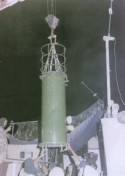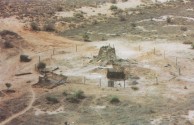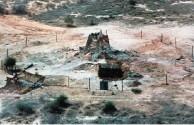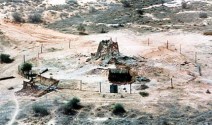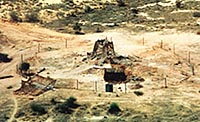Operation Shakti: 1998
"India is now a nuclear weapons state."
"We have the capacity for a big bomb now. Ours will never be weapons of aggression." Prime Minister Atal Behari Vajpayee, Thursday 14 May 1998 |
Last changed 30 March 2001
Background
Despite the U.S. government's self-declared "surprise" at India's multiple tests in May 1998, India's march towards an openly declared nuclear capability underscored by new tests was clear for a number of years.
During the last several years the Hindu nationalist Bharatiya Janata Party (Indian People's Party, or BJP) has emerged as the dominant power in domestic politics. One of its key platform issues has been its desire to make India an openly declared nuclear power. The BJP created a short-lived government for 13 days in May 1996, and it is now known that Vajpayee actually authorized nuclear tests at that time, and the devices got as far as being placed in the test shafts, before he called them off when it became evident that his government was unlikely to survive long enough to deal with the aftermath.
Two years later however, on 10 March 1998, the BJP achieved a strong electoral victory and finally succeeded in putting together a governing coalition of 13 (later 20) parties. The BJP wasted no time in making clear its intention to deploy nuclear weapons. On 18 March 1998, the day before he was sworn in as Prime Minister, PM-designate Vajpayee declared "There is no compromise on national security. We will exercise all options including nuclear options to protect security and sovereignty,". An official planning report further stated directly that the new BJP government intended to "re-evaluate the nuclear policy and exercise the option to induct nuclear weapons".
Considering the numerous test preparations that had been detected over the past three years, and Vajpayee's 1996 actual test authorization which was undoubtedly known to U.S. intelligence by that time, and after such announcements there would seem to be little excuse for being "surprised" by subsequent events. The underlying reason seems to have been a very ill advised cut-back in the analysis of imagery of the Pokhran site, combined with greater stealth on the part of the Indians. Given the considerable activity at the site over the previous three years, and the intelligence that the CIA undoubtedly had by then that Vajpayee had actually ordered tests during his previous short-lived government, it was not a difficult assessment to realize that Pokhran should be watched more carefully after Vajpayee took office, rather than less. It appears that the one NIMA (National Imagery and Mapping Agency) assigned to the site actually did detect suspicious activity on the morning of May 11, 6 hours before the tests (and about the time they were originally scheduled for detonation) and was waiting for further review of his findings when the tests were announced.
The 1998 Election
The 1998 election (like all Indian national elections) was held in phases from 16 February to 7 March.
The BJP (Bharatiya Janata Party - the Indian People's Party) had been growing steadily in strength over the past decade, riding on a wave of ethnic-religious politics advocating Hindu-based nationalism. The BJP, and its allied parties the VHP (Vishwa Hindu Parishad) and RSS (Rashtriya Swayamsevak Sangh) had been largely responsible for creating this religious separatism through agitation like the Ram Temple campaign, that had led to a mob assault on the Babri Mosque in Ayodhya and its destruction, followed by nation-wide rioting that had killed 3000.
The 1998 BJP campaign was marked by some very unfortunate grandstanding - like Prime Minister candidate Vajpayee's declaration on 25 February that a BJP government would "take back that part of Kashmir that is under Pakistan's occupation." An important part of the BJP platform was its declared intention to "exercise the option to induct nuclear weapons" - that is, to open deploy a nuclear arsenal. This was in keeping with the position that the BJP, its predecessor the Jana Sangh, and Vajpayee himself had held for 35 years that India should become an openly nuclear power to garner the respect on the world stage that India deserved. The BJP's declarations on the subject were toned down a bit from earlier years, a move that can be understood as an effort to make their program palatable to as large a segment of India's voting population as possible. The BJP had formed a 13 day government two years earlier, and needed all the support it could get to form a stable government.
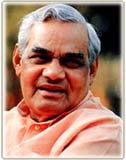 |
| Atal Behari Vajpayee |
On 10 March 1998 it was announced that the BJP had won 26 percent of the popular vote, and gained 250 seats in the Lok Sabha, 22 short of an outright majority. President Raman Narayanan gave Vajpayee the first opportunity to form a government, and after several days of negotiations he finally succeeded in putting together a governing coalition of 13 (later 20) parties. The BJP wasted no time in making clear its intention to deploy nuclear weapons. On 18 March 1998, the day before he was sworn in as Prime Minister, PM-designate Vajpayee declared "There is no compromise on national security. We will exercise all options including nuclear options to protect security and sovereignty,". An official planning report reiterated the campaign position that the new BJP government intended to "re-evaluate the nuclear policy and exercise the option to induct nuclear weapons".
Prime Minister-Elect Vajpayee consulted with Abdul Kalam the day before he was sworn in to office and asked him to join the cabinet. Kalam declined, indicating that he was needed at his current post to support the nuclear program. It is possible that at this meeting Vajpayee indicated his intention to prepare for and conduct nuclear tests. Certainly Kalam, keenly aware of Vajpayee's previous near brush with testing anticipated that tests would be imminent, and would likely have brought the subject up. Vajpayee consulted again with both Kalam and AEC Chairman R. Chidambaram on 20 March. Chidambaram had declared in an interview only days before that nuclear tests were needed. Chidambaram briefed Vajpayee extensively on the nuclear program, and the devices that had been prepared; Kalam presented the status of the missile program. At the conclusion of the meeting Vajpayee told them to be ready to test, but made no committment to conduct tests. Accordingly, the test preparations began immediately after the meeting even though the tests had not yet been approved.
On 28 March the BJP-led coalition passed a vote of confidence, 275 to 260. This was the milestone that had prevented tests from being conducted by the BJP in 1996. The way was now clear to go forward. On 9 April Vajpayee met again with Kalam and Chidambaram and asked how long it would take to conduct tests, Kalam indicated that tests could be conducted 30 days from the decision to go ahead, Vajpayee told them to fix a date and coordinate it with Brajesh Mishra, Principal Secretary to PM Vajpayee (and an ardent advocate of nuclear armament for India). The next day, the scientists reviewed preparations at Pokhran. Thirty days from 10 April was 10 May, but President Narayanan was scheduled to be touring Latin America from 26 April and 10 May. Narayanan was not in the loop on nuclear tests, and it would have been diplomatically awkward to have him surprised by the tests, and the inevitable controversy while abroad. Further, attempting to accelerate the tests by testing before 26 April would not work since Chidambaram's daughter was getting married on 27 April. Chidambaram's absence at his own daughter's wedding and preparations would have been a red flag that something was afoot. Kalam and Chidambaram provided Mishra with the date 11 May as the earliest practical date. Mishra checked the date with Vajpayee who then gave the authorization for the tests.
The atmosphere was tense in the following few weeks leading up to
Operation Shakti (Operation Power, the May 1998 nuclear test series). Pakistan's Foreign Minister Gohar Ayub (also referred to as Gohar Ayub Khan) had offered a "carrot" of soothing rhetoric on the day of Vajpayee's swearing in, saying at a Conference on Disarmament in Geneva that Pakistan would offer India "an agreement with India for an equal and mutual restraint in conventional, missile and nuclear fields."
The "stick" side of the Pakistani equation was reemphasized on 6 April when Pakistan tested a new missile, named Ghauri, with a range of 1500 km (900 miles) and a payload of 700 kg (though it flew only 800 km in this test). This missile program had been known since 1997, and Pakistan had hinted about the imminent test on 23 March, but the test came as a shock to India which had felt itself far ahead of Pakistan with the Agni program although this program had been dormant for four years now. This escalation of the strategic challenge fro Pakistan could only have strengthened Vajpayee's to conduct the tests.
In an inauspiciously timed visit, Bill Richardson, leading a high level U.S. delegation that visited New Delhi on 14 August, chose to take that opportunity to reassert the existence of a special relationship with Pakistan.
The next day, the Richardson delegation visited Pakistan. During the visit Dr. Abdul Qader Khan, the self-proclaimed father of Pakistan's nuclear weapons program, always ready to take the spotlight with inflammatory rhetoric, told the Urdu daily
Ausaf on 15 April "We are ready to carry out nuclear explosion anytime and the day this political decision will be made, we will show the world," during an informal chat with journalists. "We have achieved uranium enrichment capability way back in 1978 and after that several times we asked different governments to grant us permission to carry out a nuclear test. But we did not get the permission," the daily quoted him as saying. Asked when Pakistan would carry out a nuclear test, Dr. Khan was quoted as having said, "Get permission from the government." Khan was not a spokesman for the government at the time, but he remained extremely influential and was still closely connected with the corridors of power in Pakistan.
And throughout the 52 day period between Vajpayees swearing-in and the tests, occasional artillery and small arms fire was exchanged between the two nations, as it has been for years, on the Siachen glacier, the world's highest and coldest battlefield.
On 4 May the colorful and controversial Indian Defense Minister George Fernandes reemphasized his views on nuclear arms, saying that ""My views have not changed after I became defense minister, ... I agree with our decision not to sign the CTBT or NPT (Nuclear Non-Proliferation Treaty). We should not only keep the nuclear option open, but also think about exercising this option to make nuclear weapons". Only two days later Fernandes set off an international tiff with China when he declared China to be India's "potential enemy number one" and claimed that many tactical nuclear weapons were stationed on the Indian border. In retrospect these remarks by Fernandes seemed part of a deliberate strategy to prepare the ground for India's tests -- illustrating that India regards itself as acting on the world stage and facing threats from a recognized world power, rather than needing defenses against a regional state like Pakistan. In fact Fernandes, like the Defense Minister's who preceded him, was not in the loop regarding nuclear decisions. He was not on the very short list of government leaders who knew what was up.
1998 Weapon Development Team
Project Leaders:
- Dr. Avil (Abdul) Pakir Jainulabdeen Kalam
- Scientific Adviser to the Defence Minister
- Head of the Defence Research and Development Organization (DRDO)
- Dr. Rajagopala Chidambaram
- Chairman of India's Atomic Energy Commission (AEC)
- Chairman of the Department of Atomic energy (DAE)
Development and Test Teams
- Bhabha Atomic Research Center (BARC) Leads
- Anil Kakodkar, Director of BARC
- Satinder Kumar Sikka, Lead for Thermonuclear Weapon Development
- M.S. Ramakumar, Director of Nuclear Fuel and Automation Manufacturing Group;
Lead for nuclear component manufacture
- D.D. Sood, Director of Radiochemistry and Isotope Group;
Lead for nuclear material acquisition
- S.K. Gupta, Solid State Physics and Spectroscopy Group;
Device design and assessment
- G. Govindraj, Associate Director of Electronic and Instrumentation Group;
Lead for field instrumentation
- DRDO Leads
- K. Santhanam; lead for test site preparations
- Chairman of the Department of Atomic energy (DAE)
Test Preparations
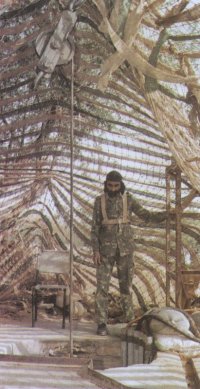
411x800, 86K |
Shaft mouth for one of the Shakti
tests. The camouflage netting is
an interesting feature. If this
was one of the three shaft dug in
the early 80s, and not used until
the Shakti I-III shots on 11 May
1998, then camoflaging it might be
a possible give-away since it
presumably would have been un-
camoflaged for almost two decades.
|
The nuclear devices were moved from their vaults at the BARC complex in Mumbai in the early morning hours of 1 May, around 3 a.m., by four Army trucks under the command of Col. Umang Kapur of the DRDO (Defence Research and Development Organization). They were transported to Mumbai airport and flown at dawn in AN-32 transports to Jaisalmer airport, two hours away. An Army convoy of four trucks took the explosive devices to Pokhran, about an hours trip from the airport. Three trips were required to complete the delivery of the devices and associated equipment. The devices were delivered directly to the device preparation building which was designated Prayer Hall.
The Shakti Test Devices |
|---|
Identifier | Description |
|---|
| Shakti I | Two stage thermonuclear device with fusion boosted primary, intended for missile warhead;
test design yield 45 kt, with a 200 kt deployed yield |
| Shakti II | Lightweight pure fission tactical bomb/missile warhead, 12 kt design yield |
| Shakti III | Fission experimental device, reportedly made with reactor-grade plutonium.
Probably a fusion boosted design without the fusion fuel, 0.3 kt design yield |
| Shakti IV | 0.5 kt experimental device |
| Shakti V | 0.2 kt experimental device |
| Shakti VI | Not fired; another low yield experimental device? |
According to Chengappa the plutonium for the devices weighed 3 to 8 kg, depending of the device, and were colored gray due to the coating applied to contain the radioactivity (and no doubt to prevent oxidation of the plutonium). The explosives surrounding the cores was colored a dull orange.
Three laboratories of the DRDO were involved in designing, testing and producing components like advanced detonators, the implosion systems, high-voltage trigger systems. They were also responsible for weaponization -- systems engineering, aerodynamics, safety interlocks and flight trials.
The tests were organized into two groups that were fired separately, with all of the devices in a group fired at the same time. The first group consisted of the thermonuclear device, the fission bomb, and a sub-kiloton device, and two more sub-kiloton devices made up the second group.
The First Tests Are Fired
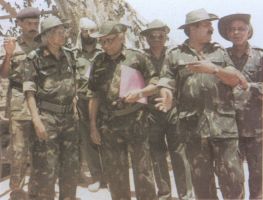
640x487, 59K |
Key scientists and engineers on 10 May 1998.
Abdul Kalam is on left (silver hair);
R. Chidambaram is holding file;
Anil Kakodkar is behind Chidambaram wearing
glasses; K. Santhanam is at extreme right.
|
The thermonuclear device was emplaced in the shaft code named White House (over 200 m deep), while the Taj Mahal shaft (over 150 m deep) was assigned to the fission bomb, and Kumbhkaran to the first sub-kiloton shot. The other three shafts for the second test series were designated NT 1,2, and 3. The Regiment 58 Engineers had learned a lot since 1995 about how to avoid detection by U.S. spy satellites. A lot of work was done at night, and heavy equipment was always returned to the same parking spot at dawn so that image analysts would conclude that they had never moved. Piles of sand were shaped to mimic the wind-aligned and shaped dune forms in the area. When cables were laid they were carefully covered and native vegetation replaced to conceal the digging.
The first three devices were emplaced on 10 May, the day before the tests. The shafts were L-shaped, with a horizontal chamber for the test device. The first device to be placed was the sub-kiloton device in the Kumbhkaran shaft. The Army engineers sealed the shaft at 8:30 p.m. Then the thermonuclear device was lowered in the White House shaft, sealing this shaft took until 4 a.m. the next morning. By then the atomic bomb was being emplaced in the Taj Mahal shaft. It was sealed at 7:30 a.m., just 90 minutes from the planned test time.
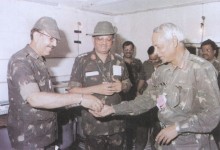
640x436, 77K |
Preparing to fire the devices in the control
bunker, code named "Deer Park." K. Santhanam
transfers the firing keys to the range safety
officer Vasudev. |
The actual timing of the tests were dependent on the local weather conditions. It was hot in the Thar Desert in early May, it reached 43 C on the day of the test. But the critical factor was the wind. Although the tests were underground, they were shallow tests and the sealing of the shaft could not be guaranteed to be leakproof (a number of shaft seal failures had occurred in the U.S. despite much deeper burials). Winds blowing toward inhabited areas, as occurred on the morning on 11 May were not acceptable. But by early afternoon the winds had died down and the scientists decided to go ahead with the tests. Prime Minister Vaypayee and Brajesh Mishra, his Principal Secretary, had waited at the official residence since at least 9 a.m. to hear the test results. Kalam called at 3 p.m. to tell the Prime Minister that the winds were dying down and the tests could be conducted during the next hour. K. Santhanam of the DRDO, who was in charge of the test site preparations, gave the two keys that activated the test countdown to Vasudev, the range safety officer, who was responsible for verifying that all test indicators were normal. After checking the indicators, Vasudev handed one key each to a representative of BARC and of the DRDO, who together unlocked the countdown system. At 3:45 p.m. the three devices detonated.
The tests were conducted on the Buddhist festival day of Buddha Purnima, the same festival day on which the 1974 test was conducted. This appears to have been a coincidence, the tests having been conducted at the earliest date that they could be made ready, though it has been widely assumed to have been intentional.
The Announcement
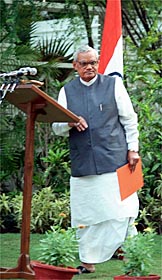
On Monday, 11 May 1998, at 10:13:44.2 UCT (+/-0.32 sec; 6:13:44.2 a.m. EDT; 3:43:44.2 p.m. local) as measured by international seismic monitors, India declared itself a full fledged nuclear armed state. This was accomplished by the detonation of a thermonuclear weapon design, one of three nuclear devices with kiloton-range yields detonated simultaneously under the surface of the Thar desert of Rajasthan near the Indo-Pakistani border. This de facto declaration was followed shortly thereafter by an official one. In a hurriedly convened press conference Indian Prime Minister Atal Behari Vajpayee said:
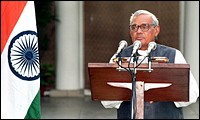
"I have an announcement to make: today at 3:45 p.m., India conducted three underground nuclear tests in the Pokhran range (in Rajasthan state).
These were contained explosions like the experiment conducted in May 1974,"
Vajpayee said Monday in a brief statement, referring to the 1974 underground 12 kiloton test known as Smiling Buddha also conducted at Pokhran. Vaypayee further stated that like the 1974 test, none of the three tests resulted in venting into the atmosphere (which was not entirely true - some venting had occurred).
He went on to say that the devices tested were a thermonuclear device, a fission device, and a low-yield device.
"I warmly congratulate the scientists and engineers who have carried out these successful tests,"
Vajpayee added.
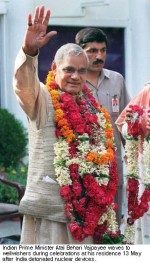
640x382, 49K |
PM Vajpayee waves to
well-wishers after the
second test series on 13 May |
In contrast to the 1974 explosion no claims that these were 'peaceful tests' were made. Indeed, government officials quickly emphasized the military nature of the explosions. "These tests have established that India has a proven capability for a weaponized nuclear program," Brajesh Mishra, Principal Secretary to PM Vajpayee, told reporters. Just two days later on 13 May, at 6:51 UCT (2:51 a.m. EST, 12.21 p.m. local Indian time) India detonated two more sub-kiloton nuclear devices underground before declaring that the test series was completed.
The test series was dubbed Operation Shakti-98 (Power-98) and the five tests are designated Shakti I through V. Like the 1974 test's moniker "Smiling Buddha", this name seems to have been stuck on the test series after the fact. The test operation itself apparently did not have a formal name. More recently it has been common to refer to the five shot test series as Pokhran II, the 1974 shot being Pokhran I.
Read the
The Tests
Seismic data collected by stations outside of India have placed the total magnitude of the first event at 5.0 (+/- 0.4), making it one of the largest seismic events in the world during the 24 hr period in which it occurred. The measured seismic center of the triple event was located at 27.0716 deg N latitude, and 71.7612 deg E longitude, which places it only 2.8 km from the 1974 test site (which was at 27.095 deg N, 71.752 deg E). The general area of these tests is usually given as Pokharan (or Pokhran), a town about 25 km away. This is area is a military test range with four areas (A through D). The test sites are just outside the abandoned village of Malka, are 6 km to the northeast of the nearest inhabited village of Khetolai (population 1200), and 10 km south of Loharki, and are about 100 km from the Indian border with Pakistan.
The first group of three tests (Shakti I, II, and III) were reported to have a combined yield of about 55 (or 58) kilotons and consisted of a two stage thermonuclear weapon design (Shakti I) with a yield of 43 kt, +/- 3 kt, (also stated to be 43-45 kt), a 12 kt test of a light compact weaponized tactical fission bomb, and a 0.2 kt tactical fission weapon. There were three shafts located about 1 km from each other and 3.5 km from the control room. The Shakti I shaft was designated "White House" (also called "Whisky"), the Shakti II shaft was known as "Taj Mahal" (also called "Tango"), and the Shakti III shaft was called "Kumbhkaran". The shots were fired simultaneously. The second phase of two tests (Shakti IV and V) had yields of 0.5 and 0.3 kilotons, and were fired in shafts designated NT 1 and 2 (for Navtala, the area where they were dug). A third device and shaft (NT 3) was prepared but was not fired. The second group of shots was conducted to generate additional data for improved computer simulation of designs.
The claimed yields of these devices is not well supported by available evidence. Assigning yields to the different devices from direct outside measurement is impossible since only the total yield of all three can be measured. For detailed discussion of this see
"What Are the Real Test Yields?".
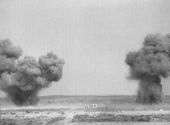
640x471, 40K |
| Dust columns from the Shakti test series on 11 May 1998 |

250x220, 21K |
| Mouth of a test shaft after the 11 May 1998 detonation. Either the White House or Kumbhkaran shaft. |
| Test: | Shakti I |
|---|
| Time: | 15:47:07 11 May 1998 (IST);
10:17:07 UCT (Indian Government), 10:13:42 UCT (USGS) |
|---|
| Location: | Pokhran, Thar Desert, Rajasthan, India
27.0716 deg N, 71.7612 deg E |
|---|
| Test Height and Type: | Underground, more than -200 m |
|---|
| Yield: | 30 kt est. (22-30 kt possible range; 43-45 kt claimed) |
|---|
This was a test of reduced yield two-stage thermonuclear bomb using a fusion boosted fission primary, apparently a 43-45 kt design test yield for a ~300 kt weapon. The available evidence indicates that the boosted primary performed correctly, but that the secondary stage failed partially.
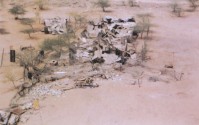
640x403, 45K | 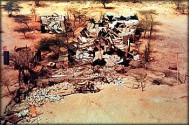
350x232, 27K | 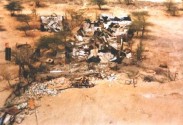
432x295, 43K |
|
| The collapsed sheds around the mouth of the White House shaft where India's thermonuclear device was tested (three versions of the same image). |
| Test: | Shakti II |
|---|
| Time: | 15:47:07 11 May 1998 (IST);
10:17:07 UCT (Indian Government), 10:13:42 UCT (USGS) |
|---|
| Location: | Pokhran, Thar Desert, Rajasthan, India
27.0716 deg N, 71.7612 deg E |
|---|
| Test Height and Type: | Underground, more than -150 m |
|---|
| Yield: | 12 kt |
|---|
This was a test of a full yield test of a lightweight pure fission tactical bomb.
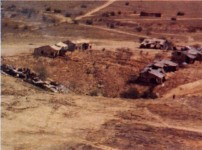
640x475, 61K |
| The subsidence crater at the site of the Taj Mahal shaft where India's tactical fission bomb was tested. Taken shortly after the shot, this aerial picture shows the test sheds still standing. The crater appears to be about 80 m across and 15 m deep. |
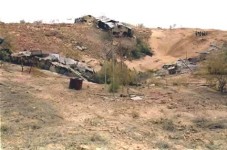
432x286, 26K |
| The Taj Mahal subsidence crater with sheds. Observe the figures standing on an observation platform built on the sand slide area, distinctive for its light color with dark streaks. |
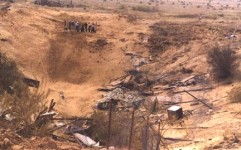
432x268, 30K | 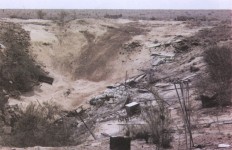
640x413, 94K | 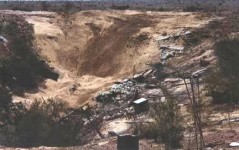
432x271, 37K |
| Later images, with the sheds missing. All are shot from roughly the same position across toward the sand slide. The second are third may be different scans of the same photograph. |
| Test: | Shakti III |
|---|
| Time: | 15:47:07 11 May 1998 (IST);
10:17:07 UCT (Indian Government), 10:13:42 UCT (USGS) |
|---|
| Location: | Pokhran, Thar Desert, Rajasthan, India
27.0716 deg N, 71.7612 deg E |
|---|
| Test Height and Type: | Underground |
|---|
| Yield: | 0.3 kt |
|---|
This device was an experimental fission device using "non-weapon grade" (reportedly reactor-grade) plutonium. It was probably a test of fusion boosted device without the boost gas to prove the ability to use lower grade plutonium from India's large power reactor plutonium stockpile.
| Test: | Shakti IV and V |
|---|
| Time: | 12:21 13 May 1998 (IST);
6:51 13 May 1998 (UCT) |
|---|
| Location: | Pokhran, Thar Desert, Rajasthan, India
27.0716 deg N, 71.7612 deg E |
|---|
| Test Height and Type: | Two shots, both shallow underground |
|---|
| Yield: | < 0.1 kt each?? (0.5 kt and 0.3 kt claimed) |
|---|
These two shots were fired in shallow shafts (NT 1 and 2) in an area known as Navtala Wells, due to the nine dry wells located close together there. These shafts were constructed very rapidly in 1996 using existing wells as the starting point for construction. One shot was fired in a sand dune, which made tunneling quite easy. Radiological measurements taken from bore holes at these shot sites, along with Shakti III have been published by BARC in a brief article (
[Attarde et al 1999]).
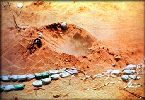
350x240, 18K | 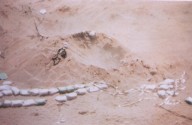
640x416, 39K | 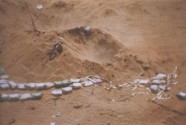
432x291, 17K |
Three versions on one image of a dune where one of the second series of sub-kiloton shots was fired.
The crater appears to be 3.5 - 4 m across. |

300x521, 39K |
| Damage in the village of Khetolai on 13 May 1998, 4-6 km from the test sites. |
The Comprehensive Test Ban Treaty (CTBT) International Data Centre originally assigned the event the ID number EVENT 1391897, but changed it to "EVENT 1392074" when subjected to manual analysis. The seismic data from the 1998 tests can be accessed from
the IDC web site, the tests are summarized with a map
here. Also see
the BGR Hannover Seismic Data Analysis Center for a nice summary of the seismic data with a map. The preliminary seismic data form the International Data Centre, which was generated automatically is in
this file, while the expert evaluated data prepared five days later is
here.
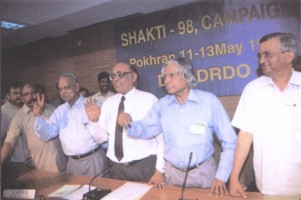
640x425, 60K |
The weapon scientists at the 16 May press
conference. From right Anil Kakodkar, Abdul
Kalam, R. Chidambaram, and K. Santhanam. |
|
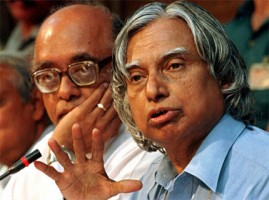
340x320, 49K |
Drs. A.P.J. Abdul Kalam and Rajagopala
Chidambaram at the press conference
following the test series. |
The Indian government held a triumphal press conference with the entire scientific and engineering leadership three days after the second group of tests. This conference was notable, even unprecedented, in the level of detail about the tests that was released - discussing yields and the general characteristics of the devices. By comparison the US and USSR/Russia has kept the exact yields and purpose the vast number underground shots dating back to the early 1960s classified up to the present day. In fact most of the information about the nature and intent of the test available almost three years after the tests were released at this press conference or in the few days following it. Most of the information was conveyed by two top officials -- Drs. Avil (Abdul) Pakir Jainulabdeen Kalam, Scientific Adviser to the Defence Minister and head of the DRDO (Defence Research and Development Organization), and Rajagopala Chidambaram, chairman of India's Atomic Energy Commission (AEC) and Department of Atomic energy (DAE). The largest device tested, Shakti I, was a two-stage thermonuclear design using a boosted fission primary which Chidambaram claimed had a yield of 43 kt (also described as 43 kt +/- 3 kt). Shakti II, the next largest device, was a refined lightweight pure fission device with a yield of 12 kt. Shakti III the third device tested on 11 May was a 0.3 kt fission device using less-than-weapon grade plutonium. Both of the devices in the second test group, with yields of 0.5 and 0.3 kilotons, were experimental devices detonated to generate additional data for improved computer simulation of weapon designs.
On the other hand, there continues to be considerable controversy about the accuracy of this information, particularly
regarding the yields of the thermonuclear device, and the second series of sub-kiloton shots. In summary the balance of the evidence indicates that the claimed yields are significantly overstated - particularly regarding the thermonuclear device, and the total yields of both test groups. The available information indicates that Shakti I could not have had a yield larger than 25 kt, but was at least 22 kt (based on Indian drilling data). The evidence offered by the Indian government to date to support the 43 kt yield claim is weak, in fact a plain reading of their own seismic evidence puts the yield at or below 25 kt. Accepting the radiological and photographic evidence for this second group of tests offered by BARC as valid, the complete absence of a seismic signal for theses shots defies explanation at the present time if the stated test time and yields are even is even remotely correct. BARC does not appear to have offered an explanation for this anomaly.

640x456, 73K |
Prime Minister Atal Behari Vajpayee visits Pokhran on
20 May 1998. Vajpayee is seated in front wearing
sunglasses. To his right is Abdul Kalam, to this left
Defense Minister George Fernandes, and R. Chidambaram.
Third from right (standing) is S.K.Sikka lead in
thermonuclear device development. |
 |
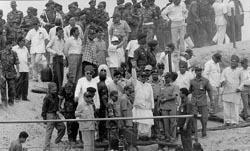 |
| Prime Minister Atal Behari Vajpayee visiting the Pokhran test site. |
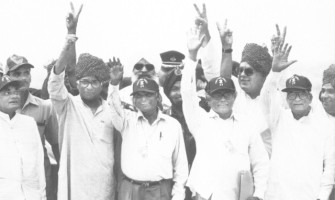
640x382, 49K
800x478, 80K |
From left, PM Vajpayee, Defense Minister George
Fernandes, Abdul Kalam, and R. Chidambaram. |
Based on this evidence the most plausible interpretation of the 11 May tests is that the fission bomb was successful and yielded 12 kt. The straightforward nature of this technology and the lengthy time India had to master it makes doubts about its performance difficult to support. The yield of the thermonuclear device was apparently 22-25 kt. This is at or above the expected yield range of a thermonuclear primary, so it appears that the fusion boosted device used for the primary was successful. The plausible yield for the secondary stage is from 10 to 15 kt, well below the 30 kt or so apparently expected by India. The 0.3 kt yield for the third device is appropriate for the unboosted yield of a boosted fission design - that is, a device that is fired without the deuterium-tritium boost gas. It suggests that India now as the ability to employ full yield fusion boosted weapons using less-than-weapon grade plutonium. This could be fuel grade plutonium as is produced by India's power reactors or perhaps an intermediate grade. In the first case all of India's considerable holdings of plutonium could be used for weapon manufacture, in the second case the stock of weapon grade material could be extended by mixing it with fuel grade plutonium. The reasons given for the second group of tests are entirely credible and are consistent with the objectives of other nuclear weapons nations in recent testing activities (either nuclear tests prior to the CTBT signing, or sub-critical tests afterward). India's stated interest in gathering high quality physical data for use in simulations is quite consistent with a well planned weapon development effort.
The use of simultaneous detonations of multiple nuclear devices has been a routine practice by other nuclear weapons states. The principal purposes of this technique are to minimize the ability of other nations to collect intelligence data about the tests (ironically too successful, given India's subsequent and not entirely convincing efforts to publicize its test results), and to reduce the cost and difficulty of test preparations. In India's case the desire to minimize political repercussions and outside pressure also motivated a compressed schedule of simultaneous tests.
Corroboration of a sort for India's explanations for the different tests on 11 May was given immediately after they were fired, and four days before the official AEC/DRDO announcements, by commentary on their military significance offered by P.K. Iyengar, the former chairman of India's AEC. On 12 May he told Reuters in Mumbai (Bombay) that their differing sizes corresponded to three ways in which nuclear bombs might be used.
According to Iyengar, the smallest was the size that might be fired as an artillery shell or dropped from a combat support aircraft. The mid-size blast was from a standard fission device equivalent to about 12 kilotons -- the size that might be dropped from a bomber plane. The largest of the three warheads tests on Monday was not a full hydrogen bomb. Most of its 50 to 100 kiloton explosive force came from the primary, a fission device which serves as a trigger for the H-bomb's big fusion explosion. Iyengar said the device contained only a token amount of the hydrogen variant tritium. It showed that India's thermonuclear technology worked, but did not produce the megaton explosion typical of a full H-bomb.
"We need not go for a megaton explosion while testing an H-bomb," said Iyengar, one of the scientists involved in India's only other nuclear test, in 1974. "Such tests are required only if we are planning for a total destruction of the opposite side. They don't have relevance in our strategy."
One technical issue that affects all three of the low yield tests, with yields of 0.2, 0.3, and 0.5 kilotons, is that the yields of low yield fission tests are very sensitive to physical parameters like the amount of fissile material present, the degree and uniformity of compression, and the nuclear properties of the materials. Even if the Indian designers have achieved very accurate control over the implosion process, without test data in this yield range to calibrate their models they would have difficulty predicting the exact yield of their devices. This of course is one reason for conducting these tests in the first place, but it also means that there is a good chance of overshooting or undershooting the target yields. Thus the
intended yields of these devices may be significantly different than the yields produced, on the other hand if the advertised yields are the expected ones, then the actual ones may be significantly different.
Initial Reactions
After the Indian tests were reported Pakistani Foreign Minister Ayub initially stopped short of saying that Pakistan would conduct a nuclear test of its own, but said "We in Pakistan will maintain a balance with India in all fields... We are in a headlong arms race on the subcontinent."
"The responsibility for dealing a death blow to the global efforts at nuclear non-proliferation rests squarely with India," he told the Senate in the Pakistani capital of Islamabad.
Others in Pakistan were not so cautious. "We have now to show that we have a counter regional bomb," Hamid Gul, the former head of Pakistan's secret service, said Monday. "All the Muslim countries are vulnerable to India's ambitions that are driving it toward the Gulf and central Asia."
Former Prime Minister Benazir Bhutto said in a BBC interview in London that her government had a contingency plan in 1996 to carry out a nuclear test if India did. She said the capability still existed, and should be used. "If we don't, India will go ahead and adopt aggressive designs on us," she said. She further indicated that the test should be conducted within the month.
Popular reaction in India was overwhelmingly positive. A
Times of India poll registered a 91 percent approval rating for the tests.
After a day of silence China's initial reaction was muted. Beijing warned that India's nuclear tests would harm peace and stability in South Asia. China is "seriously concerned" about the tests, the state-run Xinhua News Agency said in a brief report quoting Foreign Ministry spokesman Zhu Bangzao.
In general world reaction was strongly disapproving. "The United States is deeply disappointed by the decision of the government of India to conduct three nuclear tests," President Clinton's spokesman Mike McCurry said. "This runs counter to the effort the international community is making to promulgate a comprehensive ban on such testing."
"The United States intends to address its concern directly to New Delhi," McCurry said. "We will continue to spare no effort in encouraging countries to both promulgate and ratify the comprehensive test ban. If anything, these tests underscore the importance of that international regime."
Praful Bidwai, an independent Indian weapons policy analyst who had urged India to abandon its pursuit of nuclear weapons, said a thermonuclear device was a sign India's program has progressed considerably since it tested a simpler fission device in 1974. "We have dropped the ambiguity completely," he said. "China and Pakistan will regard us as a full-fledged nuclear adversary and so we will have two nuclear arms races -- a small one with Pakistan and a big one with China."
If the first group of tests evoked disapproval, the second group of tests created a flurry of consternation.
"Today? Two?," Chinese foreign ministry spokesman Zhu Bangzao exclaimed upon hearing of the second set of shots. "We have no immediate comment," he said, adding that China would study the matter.
"The Indian leadership has gone berserk," Pakistan's Foreign Minister Gohar Ayub Khan told Reuters when asked about the latest tests, and said its actions had been encouraged by a weak Western response to India's weapons program.
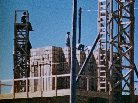 The pile of 108 tons of Composition B (a TNT/RDX mixture) prior to being blown up in the 100 Ton Test (46 K). Tumpukan 108 ton Komposisi B (campuran TNT / RDX) sebelum yang diledakkan dalam Test 100 Ton (46 K).
The pile of 108 tons of Composition B (a TNT/RDX mixture) prior to being blown up in the 100 Ton Test (46 K). Tumpukan 108 ton Komposisi B (campuran TNT / RDX) sebelum yang diledakkan dalam Test 100 Ton (46 K). 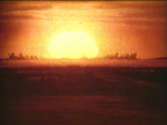
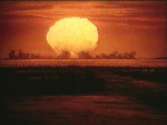
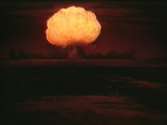
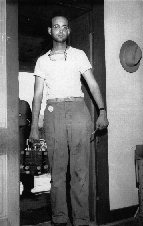
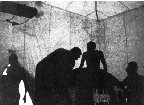 Plutonium core insertion (42 K). Plutonium penyisipan inti (42 K).
Plutonium core insertion (42 K). Plutonium penyisipan inti (42 K). 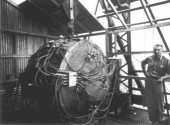 343x250, 26 K 343x250, 26 K
343x250, 26 K 343x250, 26 K 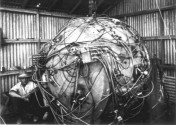 351x250, 33 K 351x250, 33 K
351x250, 33 K 351x250, 33 K 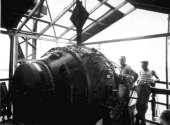 339x250, 21 K 339x250, 21 K
339x250, 21 K 339x250, 21 K 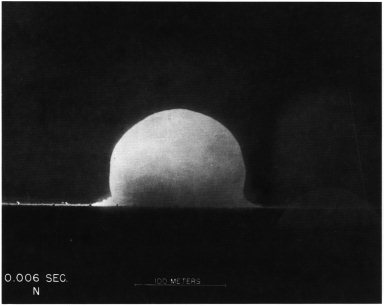
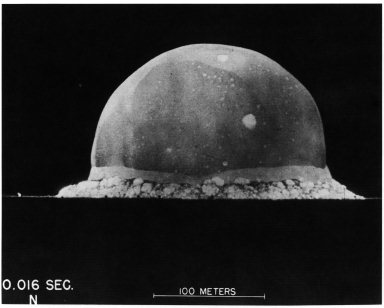
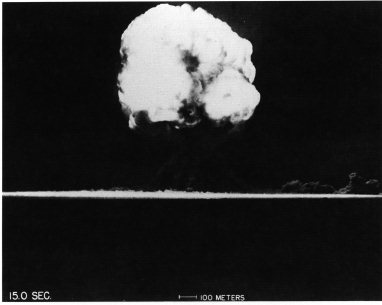
 (15 K) (15 K)
(15 K) (15 K) 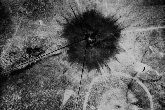
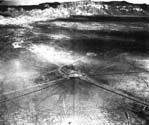 463x388, 48 K 463x388, 48 K
463x388, 48 K 463x388, 48 K 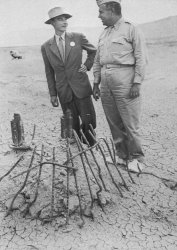 340x480, 40 K 340x480, 40 K
340x480, 40 K 340x480, 40 K  Click for bigger image (500x470, 92 K) Klik untuk gambar lebih besar (500x470, 92 K)
Click for bigger image (500x470, 92 K) Klik untuk gambar lebih besar (500x470, 92 K) 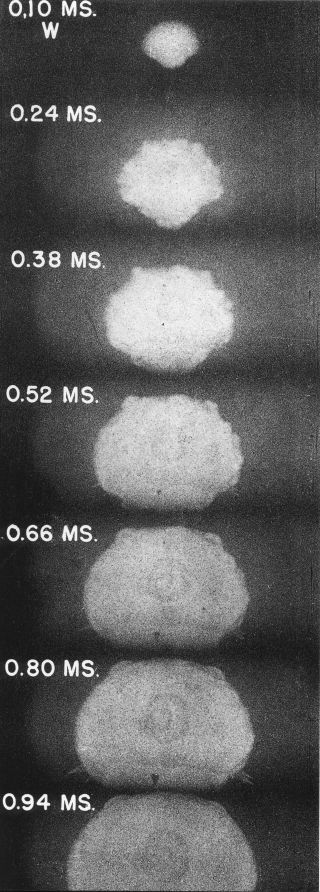
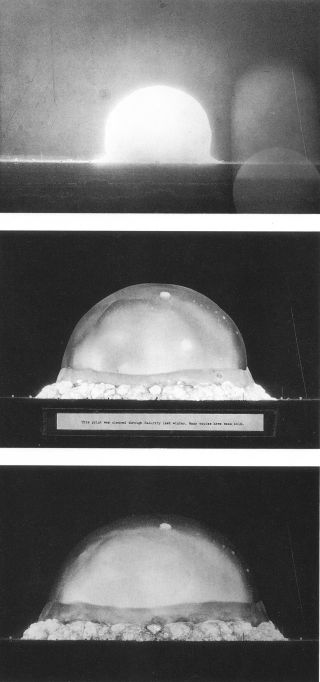
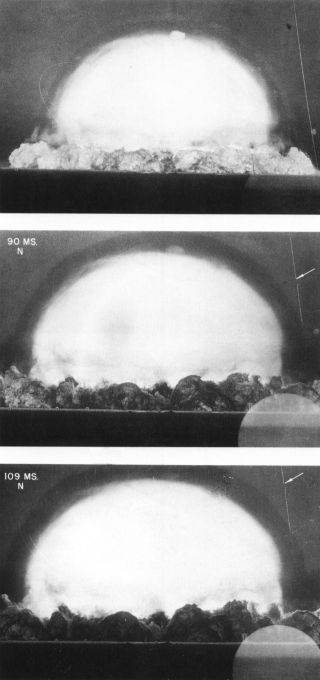




 On Monday, 11 May 1998, at 10:13:44.2 UCT (+/-0.32 sec; 6:13:44.2 a.m. EDT; 3:43:44.2 p.m. local) as measured by international seismic monitors, India declared itself a full fledged nuclear armed state. This was accomplished by the detonation of a thermonuclear weapon design, one of three nuclear devices with kiloton-range yields detonated simultaneously under the surface of the Thar desert of Rajasthan near the Indo-Pakistani border. This de facto declaration was followed shortly thereafter by an official one. In a hurriedly convened press conference Indian Prime Minister Atal Behari Vajpayee said:
On Monday, 11 May 1998, at 10:13:44.2 UCT (+/-0.32 sec; 6:13:44.2 a.m. EDT; 3:43:44.2 p.m. local) as measured by international seismic monitors, India declared itself a full fledged nuclear armed state. This was accomplished by the detonation of a thermonuclear weapon design, one of three nuclear devices with kiloton-range yields detonated simultaneously under the surface of the Thar desert of Rajasthan near the Indo-Pakistani border. This de facto declaration was followed shortly thereafter by an official one. In a hurriedly convened press conference Indian Prime Minister Atal Behari Vajpayee said:

